|

by John Major Jenkins
from
JohnMajorJenkins Website
It is important to define what the
Galactic Alignment is in precise astronomical terms.
See Glossary
below for terms.
The Galactic Alignment is the alignment of the
December solstice sun with the Galactic equator. This alignment
occurs as a result of the
precession of the equinoxes.
Precession is caused by the earth wobbling very slowly on its axis
and shifts the position of the equinoxes and solstices one degree
every 71.5 years.
Because the sun is one-half of a degree wide, it
will take the December solstice sun 36 years to precess through the
Galactic equator (see diagram below).
The precise alignment of the solstice
point (the precise center-point of the body of the sun as viewed
from earth) with the Galactic equator was calculated to occur in
1998 (Jean Meeus, Mathematical Astronomy Morsels, 1997).
Thus, the Galactic Alignment "zone" is 1998 +/- 18 years = 1980 -
2016. This is "era-2012."
This Galactic Alignment occurs only once every 26,000 years, and was
what the
ancient Maya were pointing to with the
2012 end-date of
their Long Count calendar.
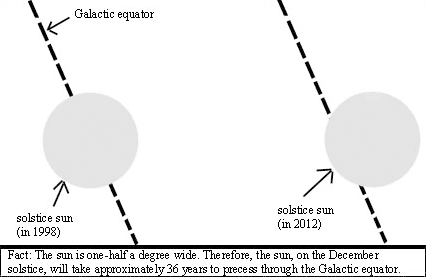
These are the astronomical facts of the
matter.
From a larger perspective, we can visualize the
2012
Galactic Alignment in the following way:
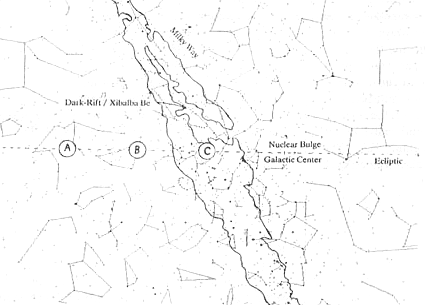
-
Position A is where the December
solstice sun was in relation to the Milky Way some 3,000 years ago
-
Position B is 1,500 years ago
-
Position
C is
"era-2012", when the December solstice sun has converged, as a
result of the precession of the equinoxes, with the exact
center-line of the Milky Way (the Galactic equator)
Notice that the
place of alignment is where the 'nuclear bulge' of the Galactic
Center is located. It is my hope that the these definitions will help to standardize
the terminology so we can clearly discuss the rare precessional
alignment that culminates in era-2012.
Glossary
-
The ecliptic:
The path
followed by the sun, moon, and planets. It is the plane of our
solar system. The ecliptic encircles the earth and is divided
into twelve constellations, or zodiac signs.
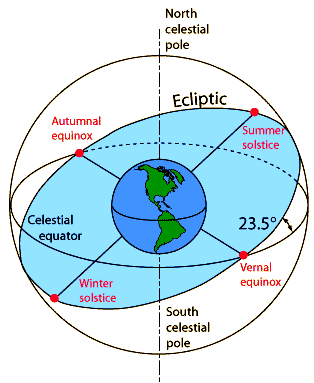
-
The Milky Way:
The bright
band of star that our solar system belongs to. It encircles the
earth and is wider in the region of Sagittarius because that is
where the 'nuclear bulge" of the Milky Way's center is located
(our Milky Way is saucer shaped). (click
below image)
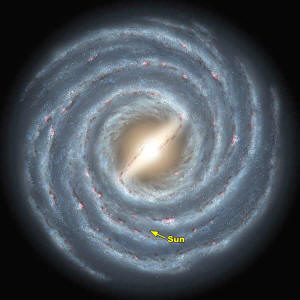
-
The Galactic equator:
The
precise mid-line running down the Milky Way. Analogous to the
earth's equator, it divides the galaxy into two hemispheres, or
lobes.
-
The Dark Rift in the Milky Way:
A feature caused by interstellar dust that runs along the Milky
Way from the Galactic Center northward past the constellation of
Aquila. (click below image)
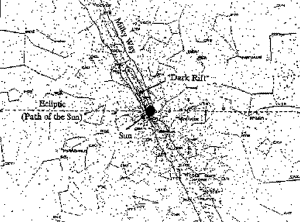
-
The December solstice sun:
The sun, on the December solstice. It is one-half of a degree
wide.
-
The December solstice point:
The precise midpoint of the sun, on the December solstice.
-
The Precession of the equinoxes:
The earth wobbles very slowly on its axis and this causes the
position of the equinox to shift backwards, or precess, through
the signs of the ecliptic at the rate of one degree every 71.5
years.
The full precessional wobble is complete in roughly
25,800 years. (click below image)
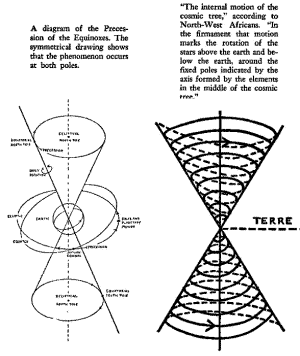
-
The vernal equinox point:
Is
defined by the intersection of the ecliptic and the celestial
equator.
-
The Celestial Equator:
The
earth's equator projected into the stars. It is the plane of the
earth's rotation (click below image)
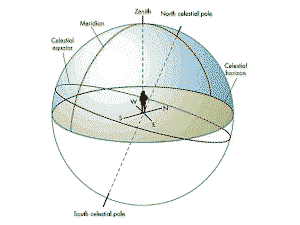
-
The Cross formed by the Milky Way
and the ecliptic:
Exactly as stated. There are two of these,
one in early Sagittarius, the other in early Gemini. The former
cross has the virtue of being located within the nuclear bulge
of the Galactic Center.
-
The nuclear bulge / the Galactic
Center:
A bright and wide region of the Milky Way, visible
to the naked eye and between Sagittarius and Scorpio. The more
precise and abstract center-point of the nuclear bulge is the
precise Galactic Center, located at about 6 degrees Sagittarius
(sidereal) and 27 degrees in the tropical zodiac.
(click below images)
Additional
Glossary of Mayan Calendar terms
-
Ahau Sequence: The sequence of five
day-signs related in the Dresden Codex which are used to predict
the morningstar risings of Venus: Ahau, Kan, Lamat, Eb and Cib.
This sequence also occurs in the same context in the Popol Vuh.
-
Calendar Round (CR): A period of 52 haab representing the synchronization of the tzolkin and haab.
-
Corr #: The "correlation number",
"correlation constant" or the "Ahau equation", i.e., the Julian
Day number which corresponds with the first day of the Long
Count Great Cycle.
-
Count of Days: Usually refers to the
260-day cycle.
-
Day-Sign Coefficient: The number
(between 1 and 13) which accompanies a day-sign.
-
Eagle Sequence: Predictive Sequence
ruled by the day-sign Eagle: Eagle (Men), Cauac, Akbal, Manik
and Chuen.
-
Eclipse Half-Year: Period of time
between eclipses - 173.3 days. Implicit in Mayan calculations.
-
Ecliptic: The 16 degree wide belt
along which the planets, moon, and sun travel.
-
Emergence Day-Signs: Day-signs on
which Venus emerges as morning star.
-
(G): Indicates the use of the
Gregorian calendar.
-
GMT: The Goodman-Martinez-Thompson
correlation number: JD 584283.
-
Great Cycle: Period of time
generated by the Mayan Long Count. Equals 13 Baktuns, 1872000
days, or approximately 5125.36 years.
-
Haab: Same as the vague solar year;
period of 365 days.
-
Hun: One
-
Hun Batz: One Monkey. God of the Popol Vuh.
-
Hun Chuen: One Monkey (or One
Artisan). God of the Popol Vuh.
-
Hunahpu: One of the Hero twins of
the Popol Vuh. Refers to the day-sign Ahau, and therefore, as
One Ahau, the traditional Sacred Day of Venus.
-
Inferior Conjunction: This occurs
when a retrograde planet crosses in front of the sun, on its way
to becoming a morningstar.
-
(J): Indicates use of the Julian
Calendar.
-
JD or J.D. #: Julian Day Number.
-
Mam: Ixil Maya term to designate the
arrival of the year-bearer (the first day of the haab; New
Year's Day).
-
New Year's Day in Mayan Calendars:
New Year's day is the first day of the haab. Since different
cultural groups followed different haab placements, New Year's
Day occurs at different times for different groups. Also, since
leap year was not recognized in the Mayan haab, New Year's Day
precesses backward around the Gregorian calendar at the rate of
one day every four years. This does not complicate the
universally shared Sacred Count of 260 days.
-
Nodal Cycle: The cycle of the lunar
nodes around the ecliptic. Approximately equals 18.4 years.
-
Oxib: Three in the Quiche language.
-
PHI: The Golden Mean or the Golden
Proportion. Although this is best expressed as a ratio, it is
usually approximated as 1.618.
-
Predictive Emergence Day-Signs:
Sequence of 5 day-signs which predict the morningstar appearance
of Venus. Similar to Predictive Sequence.
-
Predictive Sequence: The sequence of
5 day-signs which predict the morningstar appearance of Venus
after inferior conjunction. There are four possible sequences.
-
(Q): Indicates use of the Quiche haab.
-
Ruling Sequences (4): In my proposed
Venus Calendar, there are four possible Senior Day-Signs, and
each implies its own ruling sequence for the Venus Round of its
rule. The four possible Sequence Rulers are: Serpent, Dog,
Eagle, Marksman. The Ruling Sequences are implied from these
four Senior Day-Signs, after the intervals in the Dresden Codex.
-
Sacred Calendar: Although this term
can refer to the 260-day cycle by itself, it can also refer to
the complete framework of time-cycles used by the Maya.
-
Sacred Cycle: Refers to the 260-day
cycle.
-
Sacred Day of Venus: The sacred day
(including its number coefficient) which begins a Venus Round.
Example: 1 Ahau is the traditional Sacred Day of Venus. Ahau, by
itself, is simply the Senior Sacred Day (coefficient is required
to designate the Sacred Day apart from the occurrence of Ahau as
only an Emergence Day-Sign).
-
Senior Day-Sign: Usually the
Calendar Round beginning day. The most revered day-sign; can
vary from group to group.
-
Stelae: Carved monuments often found
at archeological sites. Many contain tzolkin/haab and Long Count
dates. These were called te-tuns (tree stones) by the Classic
Maya.
-
(T): Indicates the use of the Tikal
haab.
-
Tzolkin: Sacred Count of Days
(260-day cycle). Alternate meanings: "pieces of sun" or
"day-count of vibrational tree-consciousness".
-
Tzolkin/Haab: Conventional combining
of tzolkin and haab designation to indicate a unique day within
a Calendar Round period.
-
Vague Solar Year: Mayan
numerological convention - 365 days. Otherwise known as the haab.
-
Vayeb: The 5-day month which ends
the haab.
-
Venus Calendar: The system by which morningstar appearances of Venus are predicted. Consists of the
nestled cycles of tzolkin, haab, and Calendar Round.
-
Venus Cycle: The synodical period of
Venus. Equals 583.92 days; the Maya used a 584 day
approximation.
-
Venus Emergence as Morningstar: The
first day on which Venus becomes visible in the eastern morning
sky after inferior conjunction (passing in front of the sun).
Reckoned to occur 4 days after perfect inferior conjunction.
-
Venus/Mars Round: Actually, this
refers to a conjunction cycle of Venus, Mars and the Sun,
evident in the Dresden Codex. Equals 6 Calendar Rounds.
-
Venus Rising: The date on which
Venus emerges as morningstar.
-
Venus Round (VR): The period of 104 haab which synchronizes the primary cycles of Mayan time - the
tzolkin and haab. Also provides a framework by which the
astronomical phenomena associated with Venus can be predicted.
-
Xbalanque: One of the hero twins
from the Popol Vuh. Refers to the day-sign Ix and the full moon.
-
Xibalba: The Mayan Underworld.
-
Year-Bearers: The sequence of four
day-signs on which the first day of the haab can occur. There
are 5 different year-bearer sequences, or types, labelled in
Roman numerals: I, II, III, IV and V.
-
Zero Counting: zero counting was
used by various groups to count haab months from 0 to 19. The
Ixil and Quiche dropped zero counting at some point and began
counting their haab months from 1 to 20.
We can have a more general discussion of
galactic alignments in history if we consider that the solstice axis
aligns with the galactic equator every half precession cycle.
Likewise, the equinox axis aligns with the galactic equator every
half precession cycle. Thus, galactic alignments, more generally
speaking, occur in era 2012 (1980 - 2016) and every quarter
precession cycle before and after era 2012.
In terms of Mayan astronomy and mythology, the Dark Rift feature
(which the Maya called the Black Road or Xibalba be) lies along the
galactic equator (the Milky Way) in the place where the December
solstice sun will be in 2012.
(More precisely, the December solstice
sun will reach the southern terminus of the Dark Rift, where it
touches the ecliptic in Sagittarius.)
Thus, in terms of Mayan mythology, we
can also describe the Galactic Alignment of era-2012 as the
alignment of the December solstice sun and the Dark Rift. This
entire region is targeted by the cross formed by the Milky Way and
the ecliptic between Sagittarius and Scorpio. This Cross was also
recognized by the Maya, and was called the Crossroads or Sacred
Tree.
This entire region is embraced by what astronomers call the
'nuclear bulge' of the Galactic Centerthe center of our Milky Way
galaxy.
As any amateur astronomer or naked-eye
star gazer knows, this nuclear bulge is recognizable without the aid
of radio telescopes. It is wider and brighter than other parts of
the Milky Way. So, in a general sense we can also say that the
alignment in 2012 is an alignment between the December solstice sun
and the Galactic Center.
However, since the nuclear bulge is quite
large, this definition is not as precise as saying "the alignment of
the December solstice sun with the Galactic equator", which occurs
in the range 1980 - 2016.
This is the alignment zone I refer to with
the term "era-2012."
|












